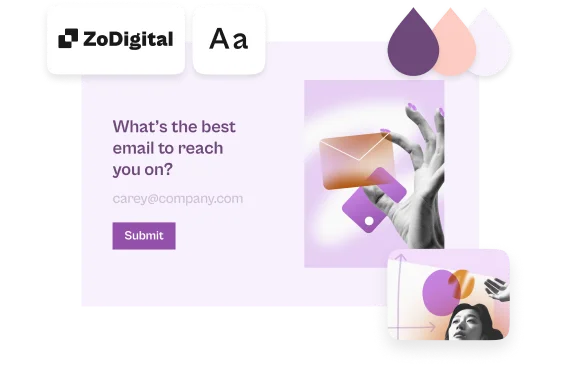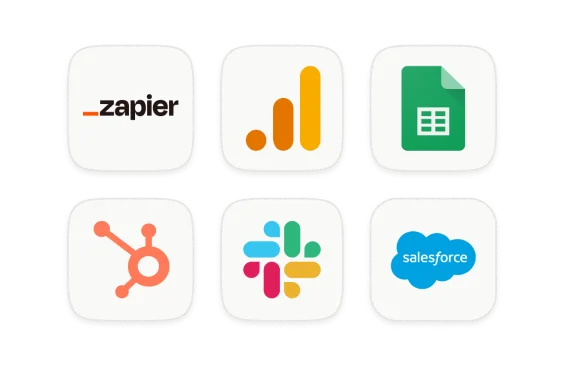Amplitude is a product analysis software company. They build a Typeform quiz “How well do you know your customers?” to help business owners understand why they might - or might not - need a service like Amplitude.
The quiz has become one of the top performing CTA assets on the company’s blog. It serves as a way for Amplitude to generate leads and share useful content with their target audience.
Here’s the quiz in action:
We caught up with the creator of the form, Cara Harshman, Head of Content Marketing at Amplitude in our blog article. In this guide, Cara walks us through how the project was built. In this article, you'll learn:
- How to create a personality quiz — from planning it to building it.
- How to send respondents tailored follow-up emails based on their responses, using Zapier and either Gmail or Marketo.
Over to Cara…
Part One: Draft the brief
I started with the idea: let’s make a quiz that gives people a score on how well they understand user behavior. I wrote a brief that articulated my vision and list of deliverables:
Part Two: Plan the questions
The first step was question planning. I asked Mike, a PM on our team for an hour of his time to brainstorm questions. In our first meeting, I set the context for my vision and goals of the quiz. I also made sure he knew the time commitment I was asking of him—about three hours in total.
Then we brainstormed a list of the activities that highly-customer centric product managers do.
We worked backward from there to generate questions that would suss out those activities. I organized all the questions in a Google Doc and used Asana to project manage all the steps to create the form:

After two meetings with Mike, we had a rough draft of questions that I polished and wordsmithed.
Part Three: Set up the scoring
Then came scoring. I knew I wanted three outcomes of the quiz. Either you are “best friends”, “acquaintances” or “strangers” with your users. That idea came early. The question was: what were the right thresholds of scores to qualify for each outcome?
To test it, I laid out the form with all the scoring and sent out an early version to the product team at Amplitude. I said, “take this quiz and let me know your score and if you agree based on how you answered the questions.” It turned out my initial scoring was too harsh—people got acquaintances when they really felt like best friends—so I made it a bit more lenient.
This is how the form was set up:
1. The form starts with a Yes/No question to find out if the person knows which features of their product are most popular.
2. I set up Logic to direct the respondent to a follow-up Multiple Choice question if they answer ‘Yes’ to this first question, to ask how they know this.
3. I then added the rest of the question, comprising of one, two-option Multiple Choice question, then seven Yes/No questions.
4. Scoring was applied to each question using Calculations. A score of +1 is applied to answers that are positive (i.e. where the person demonstrates that they understand user behavior). Zero is scored for negative responses.
5. In the case of the three-option Multiple Choice question, additional scoring is applied based on how “perfect” their answer is.
6. After applying the calculations to each question, three Endings are needed in order to tell the person if they are “strangers”, “acquaintances”, or “best friends” with their users, based on the scoring. More on how this is done in step eight.
7. A button redirect link is applied to each End Screen. This is used to send the respondent to Amplitude’s Guide to Understanding User Behavior landing page when the person completes the quiz.
8. Calculations and Logic are used to get the right Ending to appear based on what the person answers. Three Logic jumps are applied, directing the person to the appropriate Ending based on the Score thresholds, as follows:
Part Four: Polish the design
Meredith, our graphic designer, added a custom image on the Welcome Screen and custom colors within our brand palette. She also removed the Typeform branding.
1. The graphic that Meredith designed was added to the Welcome Screen, along with a headline and strapline.
2. We customized the color scheme via the Design tab. The theme was altered to suit the Amplitude brand. This included changing the font and altering the colors of the questions, answers, buttons, and background. Find out more about customizing themes in this Help Center article.
3. Typeform branding was removed from Amplitude’s quiz. To do this, head for the Settings menu (gear icon) within the Create panel and switch off the Typeform branding toggle. You can find more information on removing branding here.
Part Five: Apply UTM tracking
We use UTM tracking to pass parameters like source or medium. These allow us to see how a respondent lands on the quiz. I found it helpful at first when we were promoting the quiz through email.
You can find out more about Hidden Fields and how to set them up to track the source of visitors to your forms in this Help Center article.
Part Six: Create the follow-up emails
The last part of building the quiz was crafting the follow-up emails. The most valuable part of this quiz was the trigger email we sent with a specialized list of resources to help you move up the ladder. I wrote a draft of each of the three emails, added the links I thought would fit best and asked Carter, another PM at Amplitude to review:
We made one for “strangers”…

One for acquaintances…

And one for “best friends”…

I wanted the emails to come from a real person so I set them up to come directly from Carter. I used Zapier to setup a Gmail – Typeform integration so the follow-up emails would come from Carter@amplitude.com. I did a bunch of testing internally. Once all the bugs were removed, the flow was perfect, and all the email follow ups worked, I launched it into the world!
Here’s how to set up the Gmail integration:
1. Log into Zapier and Click the Make a Zap button. Search for Typeform and select it as your Trigger app.
2. The trigger for sending the email will be the submission of the typeform.
3. Connect your Typeform account by signing in and entering your API key (find this in your Account Settings). Then select the typeform that you want to use to trigger the email:
4. After fetching the sample responses (just follow the on-screen instructions), it’s time to add an Action app. In this case, it’s Gmail, so search for it and select it.

5. We want Gmail to send an email to the person when they complete the typeform, so select this option.
6. Connect to your Gmail account when prompted. Now you need to set up your email by piping the data you collect in your typeform to the appropriate field. Start by mapping the typeform’s Email question to the To field.

7. Now finish completing the fields. In the case of the Amplitude quiz there are three different emails (“strangers”, “acquaintances”, and “best friends”). We’ll explain how to set up which one to send in the next step. Let’s start with the “strangers” variant. Copy in the subject line and email body test into the spaces provided.

8. Zapier will now prompt you to test out the step to finish off. Once this is done you’ll need to set up a Filter to only send this variant of the email to the respondents who were deemed to be “strangers”. Do this by clicking on the little + button in between the Trigger and the Action sections and hitting the Filter button.
9. Now you can tell Zapier to only send the mail if the Score value in the typeform is less than 6 (this follows the same logic for the “stranger” categorization as the typeform).

10. Once you’re done with this Filter, you’ll need to repeat steps 1-9 for the other email variants (in Amplitude’s case “acquaintance” and “best friend”), copying in the corresponding subject lines and body email copy.
The filtering in these two cases looks like this for the “acquaintance” email:

…and this for the “best friend” email:

Part Seven: Send leads to Marketo
We use Marketo as a CRM. Weekly, we do a manual upload of new typeform respondents to Marketo.
Note: it is possible to set up a Zap to connect Typeform with Marketo, although it does require a subscription to Zapier Premium. With this, you are able to set up an action that creates/updates a lead, adds a lead to a list, or perform a search to find a lead whose email matches the search criteria.

Now it’s your turn…
Now you’ve seen how Amplitude did it, why not build your own personality quiz campaign to engage your audience and generate new leads? If you end up making something you’re proud of, do let us know all about it here and perhaps we’ll feature your typeform in our Inspiration section, too!
Want a quicker way to make your personality quiz? Check out this pre-made template and customize it to your needs.


